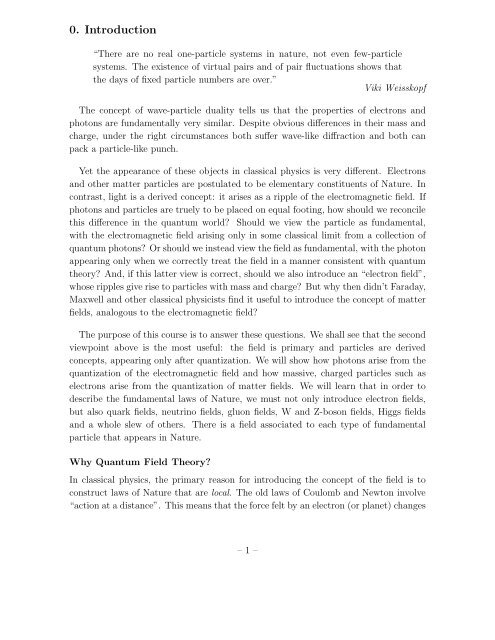Quantum Field Theory
Quantum Field Theory
Quantum Field Theory
You also want an ePaper? Increase the reach of your titles
YUMPU automatically turns print PDFs into web optimized ePapers that Google loves.
0. Introduction“There are no real one-particle systems in nature, not even few-particlesystems. The existence of virtual pairs and of pair fluctuations shows thatthe days of fixed particle numbers are over.”Viki WeisskopfThe concept of wave-particle duality tells us that the properties of electrons andphotons are fundamentally very similar. Despite obvious differences in their mass andcharge, under the right circumstances both suffer wave-like diffraction and both canpack a particle-like punch.Yet the appearance of these objects in classical physics is very different. Electronsand other matter particles are postulated to be elementary constituents of Nature. Incontrast, light is a derived concept: it arises as a ripple of the electromagnetic field. Ifphotons and particles are truely to be placed on equal footing, how should we reconcilethis difference in the quantum world? Should we view the particle as fundamental,with the electromagnetic field arising only in some classical limit from a collection ofquantum photons? Or should we instead view the field as fundamental, with the photonappearing only when we correctly treat the field in a manner consistent with quantumtheory? And, if this latter view is correct, should we also introduce an “electron field”,whose ripples give rise to particles with mass and charge? But why then didn’t Faraday,Maxwell and other classical physicists find it useful to introduce the concept of matterfields, analogous to the electromagnetic field?The purpose of this course is to answer these questions. We shall see that the secondviewpoint above is the most useful: the field is primary and particles are derivedconcepts, appearing only after quantization. We will show how photons arise from thequantization of the electromagnetic field and how massive, charged particles such aselectrons arise from the quantization of matter fields. We will learn that in order todescribe the fundamental laws of Nature, we must not only introduce electron fields,but also quark fields, neutrino fields, gluon fields, W and Z-boson fields, Higgs fieldsand a whole slew of others. There is a field associated to each type of fundamentalparticle that appears in Nature.Why <strong>Quantum</strong> <strong>Field</strong> <strong>Theory</strong>?In classical physics, the primary reason for introducing the concept of the field is toconstruct laws of Nature that are local. The old laws of Coulomb and Newton involve“action at a distance”. This means that the force felt by an electron (or planet) changes– 1 –
















